Invasive Species: Stellaria media, Common Chickweed
Common chickweed is an invasive annual, low-growing herb native to Europe. Stems are decumbent, to 19.7 in. (50 cm) long with a longitudinal line of hairs. Leaves are opposite, oval, to 0.8 in. (2 cm) long, and pointed at the tip. Older leaves are petiolate. Flowering occurs in early spring when small, white flowers develop in the leaf axils or in terminal clusters. Flowers have five cleft petals, therefore, appearing to have 10. Fruits are very small and are covered by extremely hairy calyces. Common chickweed occurs in shady, moist locations and can commonly threaten habitats on rocky seeps.
What are invasive species and why should we be concerned about them?
Taxonomy: Scientific and Common Names for This Species
Caryophyllales > Caryophyllaceae > Stellaria media (L.) Vill.
Synonym(s): chickweed, nodding chickweed, stitchwort, starwort
Stellaria media – USDA PLANTS Profile
Distribution Maps
Common chickweed – The reported distribution of this invasive species across the United States (Source: Invasive Plant Atlas of the United States)
Up-to-the-minute distribution maps and why they are important
Reporting This Invasive Species
What is the best way and place to report the occurrence of an invasive species?
How to report an invasive species sighting to EDDMapS – Early Detection & Distribution Mapping System
EDDMapS – Report an Invasive Species to EDDMapS.
Cooperative Extension Offices – Find your local Cooperative Extension office on this map provided by USDA.
How to Identify
This invasive species can be identified by looking for the characteristics described in the paragraphs that follow.
Plant
Common chickweed is an annual, low-growing herb. Stems are decumbent, to 19.7 in. (50 cm) long with a longitudinal line of hairs.
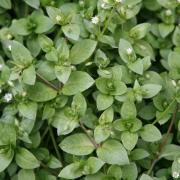 |
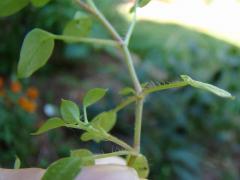 |
|
Robert Vidéki, Doronicum Kft., bugwood.org |
Rebekah D. Wallace, University of Georgia, bugwood.org |
Foliage
Leaves are opposite, oval, to 0.8 in. (2 cm) long and pointed at the tip. Older leaves are petiolate.
 |
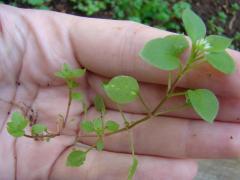 |
| Bruce Ackley, Ohio State University, bugwood.org | Rebekah D. Wallace, University of Georgia, bugwood.org |
Flower
Flowering occurs in early spring when small, white flowers develop in the leaf axils or in terminal clusters. Flowers have five cleft petals, therefore, appearing to have 10.
 |
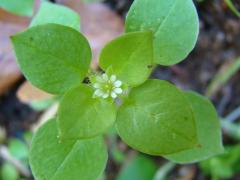 |
| Rebekah D. Wallace, University of Georgia, bugwood.org | Rebekah D. Wallace, University of Georgia, bugwood.org |
Fruit
Fruits are very small and are covered by extremely hairy calyces.
 |
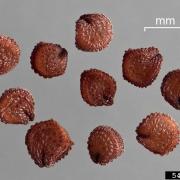 |
| Bruce Ackley, Ohio State University, bugwood.org |
D..Walters and C. Southwick, Table |
Native Species That Can Resemble Common Chickweed
– Images at invasive.org
 |
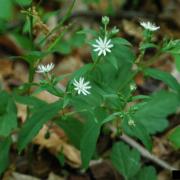 |
| Wendy VanDyk Evans bugwood.org |
Karan A. Rawlins, University of Georgia, |
– Images at invasive.org
| bugwood.org | bugwood.org |
Additional Images for Common Chickweed
Common chickweed – Images at Invasive.org
Additional Information, Biology, Control and Management Resources
Control and management recommendations vary according to individual circumstances. Location, habitat, weather, and a variety of other conditions are factors that help determine the best treatment choice. To find the safest and most effective treatment for your situation, consult your state’s land-grant institution. If you will use chemicals as part of the control process, always refer to the product label.
United States Land-Grant University System – Find your land-grant university’s college of agriculture, Cooperative Extension office, or other related partner on this map provided by USDA.
Invasive Plants Established in the United States that are Found in Asia and Their Associated Natural Enemies – USDA Forest Service
Invasives Database – TexasInvasives.org
Common chickweed – University of California Statewide IPM Program
Stellaria media – Pacific Island Ecosystems at Risk (PIER)
Pests in Gardens and Landscapes – Agriculture and Natural Resources, University of California
Non-Native Plant Species of Alaska – University of Alaska, Anchorage
